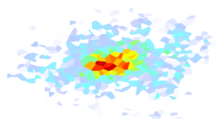shakemap.utils.probs¶
-
shakemap.utils.probs.get_weights(origin, config)[source]¶ Get list of GMPEs and their weights for a given earthquake.
- Parameters:
origin (Origin object) – ShakeMap Origin object, containing earthquake info.
config (dict-like) – Configuration information regarding earthquake type.
- Returns:
- Tuple with elements that are:
list of strings indicating the GMPEs selected for this earthquake.
ndarray (float) of GMPE weights.
Pandas series containing STREC output.
- Return type:
-
shakemap.utils.probs.get_probs(origin, config)[source]¶ Calculate probabilities for each earthquake type.
- The results here contain probabilities that can be rolled up in many ways:
The probabilities of acr, scr, volcanic, and subduction should sum to one.
The probabilities of acr_X,scr_X,volcanic_X, crustal, interface and intraslab should sum to 1.
The probabilities of acr_X should sum to acr, and so on.
- Parameters:
origin (Origin object) – ShakeMap Origin object, containing earthquake info.
config (dict-like) – Configuration information regarding earthquake type.
- Returns:
- Probabilities for each earthquake type, with fields:
acr Probability that the earthquake is in an active region.
acr_X Probability that the earthquake is in a depth layer of ACR, starting from the top.
scr Probability that the earthquake is in a stable region.
scr_X Probability that the earthquake is in a depth layer of SCR, starting from the top.
volcanic Probability that the earthquake is in a volcanic region.
volcanic_X Probability that the earthquake is in a depth layer of Volcanic, starting from the top.
subduction Probability that the earthquake is in a subduction zone.
crustal Probability that the earthquake is in the crust above an interface.
interface Probability that the earthquake is on the interface.
intraslab Probability that the earthquake is in the slab below interface.
STREC results
- Return type:
-
shakemap.utils.probs.get_region_probs(eid, depth, strec_results, config)[source]¶ Calculate the regional probabilities (not including subduction interface etc).
- Parameters:
- Returns:
- Probabilities for each earthquake type, with fields:
acr Probability that the earthquake is in an active region.
acr_X Probability that the earthquake is in a depth layer of ACR, starting from the top.
scr Probability that the earthquake is in a stable region.
scr_X Probability that the earthquake is in a depth layer of SCR, starting from the top.
volcanic Probability that the earthquake is in a volcanic region.
volcanic_X Probability that the earthquake is in a depth layer of Volcanic, starting from the top.
subduction Probability that the earthquake is in a subduction zone.
- Return type:
-
shakemap.utils.probs.get_subduction_probs(strec_results, depth, mag, config, above_slab)[source]¶ Get probabilities of earthquake being crustal, interface or intraslab.
- Parameters:
- Returns:
- Probabilities for each earthquake type, with fields:
crustal Probability that the earthquake is in the crust above an interface.
interface Probability that the earthquake is on the interface.
intraslab Probability that the earthquake is in the slab below interface.
- Return type:
-
shakemap.utils.probs.get_probability(x, x1, p1, x2, p2)[source]¶ Calculate probability using a ramped function.
The subsections and parameters below reflect a series of ramp functions we use to calculate various probabilities.
p1 |----+ | | | p2 | +------- | +----------------- x1 x2
- Parameters:
- Returns:
Probability at input x value.
- Return type:
